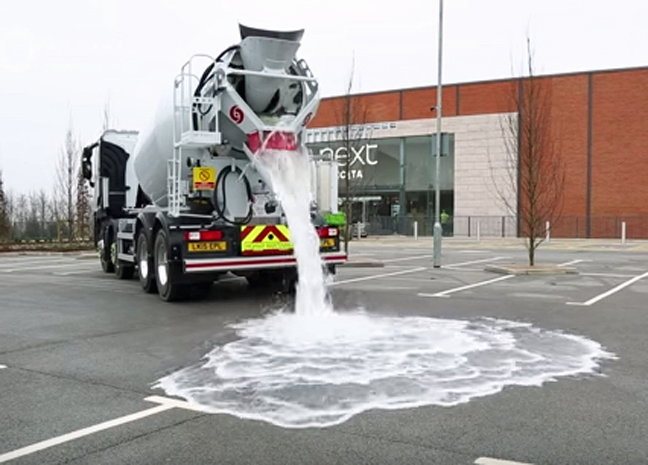Image Credit: Image #1: YouTube
Image Credit: Image #1: YouTube Porous pavement allows water to pass through to a layer of crushed rock below, rather than sheeting off the surface to storm drains. In this sample placed in Milwaukee, conventional concrete is on the left, porous pavement on the right.
Image Credit: Image #2: Aaron Volkening / Flickr
There’s nothing especially new about porous asphalt pavement, a material that allows stormwater to pass directly into the ground rather than directing it to a storm drain. But a new video posted at YouTube is proving to hundreds of thousands of fascinated viewers just how effective it can be.
Conventional pavement is impermeable, so when it rains the water sheets off — at times overwhelming storm drains and carrying a variety of pollutants with it. Porous pavement allows water to run through, into a bed of packed stone below and eventually recharging groundwater without the damage that uncontrolled runoff can cause.
The video, posted in August by Lafarge Tarmac in the U.K., has racked up more than 333,000 views to date. It shows what looks like a concrete truck dumping water onto the surface of a parking lot paved with Topmix Permeable. Instead of pooling around the truck, the torrent of water disappears almost magically into the pavement.
The surface can absorb more than 1,000 gallons of water a minute, according to a report at the website ConstructionDive, because of the gaps built into the mix. It’s absorbed into a thick layer of stone beneath the pavement and eventually permeates into the ground or is diverted elsewhere by a network of pipes.
Controlling flash floods
Runoff isn’t a trivial problem. In a 2009 article, Environmental Building News estimated that there are nearly 38,000 square miles of pavement in the U.S., an area about the size of Indiana. Almost all of it is impermeable. In cities with older wastewater systems, storm runoff can overwhelm water treatment plans and force untreated waste into local waterways.
Wider use of porous paving materials could reduce runoff damage, a problem that is likely to get worse in the future, The Atlantic reports. In promoting its new product, Lafarge Tarmac points to the 2007 floods in Great Britain that did $4.8 billion in damage. Two-thirds of the 57,000 houses affected by flooding were damaged by stormwater runoff, not rivers that overflowed.
There are some limitations to porous pavement. For one, it’s not as good as conventional asphalt or concrete in handling heavy loads, making it better suited to driveways, some parking lots and lightly traveled residential streets than major highways.
In addition, the surface can become contaminated with dirt, sawdust or silt, diminishing its ability to let water pass through. And although Lafarge Tarmac says Topmix has “excellent freeze-thaw resistance,” there are some concerns that water freezing in the material is a potential problem, The Atlantic said.
The National Asphalt Pavement Association (NAPA) says that the underlying stone bed makes porous pavement more expensive to install than conventional asphalt. But those costs are more than offset because parts of a standard stormwater management system can be eliminated, generally making porous asphalt a less expensive alternative.
In addition, NAPA says at its website, porous pavement has proved to be extremely durable. A parking lot at the Walden Pond State Reservation in Massachusetts, paved in 1977, has never been repaved and still drains effectively.
Weekly Newsletter
Get building science and energy efficiency advice, plus special offers, in your inbox.














0 Comments
Log in or create an account to post a comment.
Sign up Log in